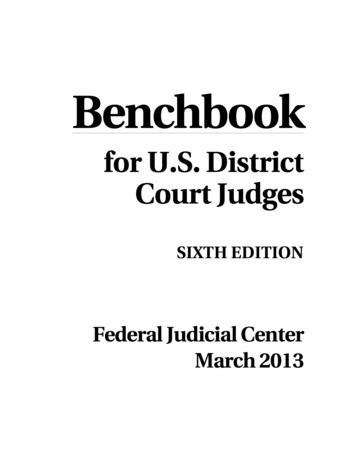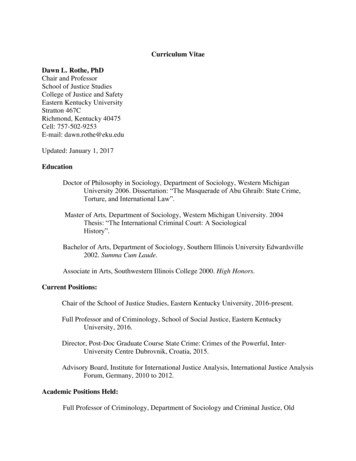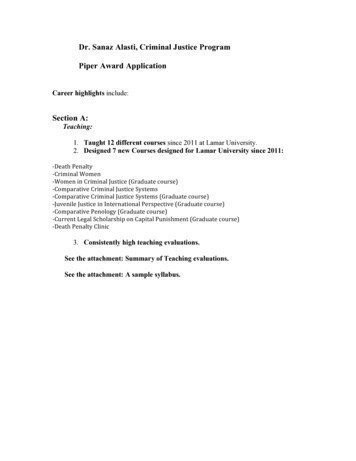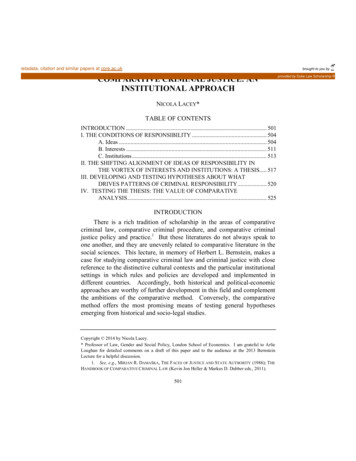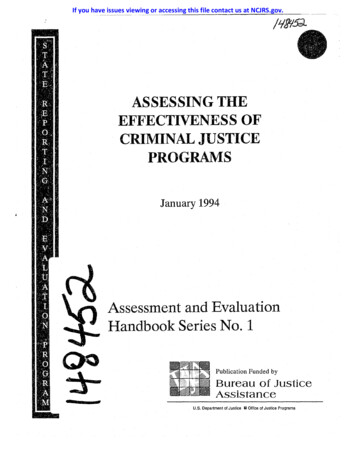
Transcription
If you have issues viewing or accessing this file contact us at NCJRS.gov.ASSESSING THEEFFECTIVENESS OFCRIMINAL JUSTICEPROGRAMSJanuary 1994Assessment and EvaluationHandbook Series No.1Publication Funded byBureau of JusticeAssistancerFU.S. Department of Justice Iii! Office of Justice Programs
About the Bureau of Justice AssistanceThe Bureau of Justice Assistance administers the Edward Byrne Memorial State and Local Law EnforcementAssistance Program to support drug control and system improvement efforts focused on state and local criminaljustice systems. The Bureau's mission, directed by the Anti-Drug Abuse Act of 1988, is to provide funding andtechnical assistance to state and local units of government to combat crime and drug abuse. Through fundingand technical support, the Bur-.",' assists the states in managing the growing numbers of anti-drug programs andthe rapidly increasing volume of drug cases entering the criminal justice system. It also identifies, develops, andshares programs, techniques, and information with the states to increase the efficiency of the criminal justicesystem, as well as provides training and technical assistance to enhance the expertise of criminal justicepersonnel. The Bureau accomplishes these mandates by funding innovative demonstration programs, some ofwhich are national or multi jurisdictional in scope; by evaluating programs to determine what works in drugcontrol and system improvement; and by encouraging the replication of successful models through linkages withthe Formula Grant Program and other resources.The Director of the Bureau is appointed by the President and, upon confirmation by the Senate, serves at thePresident's pleasure. The Director establishes the priorities and objectives of the Bureau and has final authorityto approve grants, contracts, and cooperative agreements. In establishing its annual program, the Bureau isguided by the priorities of the Attorney General, U.S. Department of Justice, Office of Justice Programs, andthe needs of the criminal justice community.148452U.S. Department of JusticeNational Institute of JusticeTh;s document has been reproduced exactly as received from theperson or organization originating it. Points of view or opinions stated inthis document are those of the authors and do not necessarily representthe official position or policies of the National Institute of Justice.Permission to reproduce this . . ) 'O?1J material has beengranted by b1icDomain/OJP/BJAU.S. Department of Justiceto the National Criminal Justice Reference Service (NCJRS).Further reproduction outside of the NCJRS system requires permissionof the owner.This report was prepared under cooperative agreement #92-DD-CX-K026, provided by the B'Jreauof Justice Assistance, Office of Justice Programs, U.S. Department of Justice. The points of viewor opinions stated in this Jocument do not represent the official position or policies of the U.S.Department of Justice.The Bureau of Justice Assistance is a component of the Office of Justice Programs which alsoincludes the Bureau of Justice Statistics, the National Institute of Justice, the Office of JuvenileJustice and Delinquency Prevention, and the Office for Victims of Crime.
ASSESSING THEEFFECTIVENESS OFCRIMINAL JUSTICE PROGRAMSAssessment and EvaluationHandbook Series Number 1Developed and Written byRobert A. KirchnerRoger K. PrzybylskiRuth A. CardellaOCT' 4 1994ACQUiiSHTKONSJanuary 1994Sponsored by theState Reporting and Evaluation ProgramPrepared byThe Justice Research and Statistics Association444 North Capitol Street, N. W.Suite 445Washington, DC 20001
INTRODUCTIONThis Handbook is designed to aid criminal justice policy makersand program managers in assessing the effectiveness of theirprograms. In developing the Handbook, an attempt has been madeto apply the concepts, principles, and techniques embodied inevaluation literature to fit the characteristics and uniqueness of thevast types of criminal justice programs being implemented acrossthe nation. First, the Handbook proposes general criteria toidentify program effectiveness and poses several questions designedto tell a program manager to what extent their program is effective.The second goal is to describe methods on how to translate thegeneral criteria into specific program elem nts which are necessaryto evaluate programs. Finally, specific program examples showhow these program elements can be used to measure the extent towhich programs are achieving their goals and objectives.Robert A. Kirchner is Chief of Program Evaluation, and Ruth A.Cardella was a Program Analyst with the Bureau of JusticeAssistance. Roger Przybylski is the Coordinator of Research,Research and Development Division, Chicago Police Department.1
Assessing the Effectiveness of Criminal Justice able of ContentsI.II.ITI.11Undedying Premise of Assessment and Evaluation1Assessing Program Effectiveness: Overview3Program Effectiveness Criteria4IV. Development of a Standard Program Effectiveness ModelV. Implementing the Program Effectiveness ModelStepStepStepStepStep12345-Program DescriptionProgram Goals and ObjectivesProgram ActivitiesFlow Model of Program StructurePerformance MeasurementVI. Conclusion56679101114Glossary of Terms15Evaluation Reference Materials21APPENDIXAProgram Example: Organized Crime/NacoticsTrafficking Enforcement (OeN) ProgramBProgram Example: Community Oriented Policing (COP)Program.11,
Assessment and Evaluation Handbook Series No. 1ASSESSING THE EFFECTNENESS OFCRIMINAL JUSTICE PROGRAMSI.Underlying Premise of Assessment and EvaluationThe need to focus on innovative programs which are successfully contributing to the Statestrategies emphasizing drug control, violent crime and criminal justice system improvementis well recognized. The study of individual programs, locate.d across the country, will helpidentify "what works," and what may be transferrable to other locations. These studies beginwith in-depth analysis of each program likely to produce useful results.The Bureau of Justice Assistance (BJA) assesses the effectiveness of substance abuseprevention programs for the purpose of finding out how well they have been implementedand to compare the extent to which the activities funded have achieved the program's goals.Such assessments are designed to provide administrators and policy makers with an impr»vedunderstanding of whether specific activities accomplish their desired results of enhancing theeffectiveness of the stated program strategies.Program evaluation is defmed as follows:A systematic assessment of the results or outcomes of program efforts to measure actualoutcomes against the intended outcomes of the program; to discover achievement andresults; to discover deviations from planned achievements; to judge the worth of theprogram; to identify unintended consequences; and to recommend expansion, contraction,elimination, or modification of the program.It is obvious from the preceding definition that program evaluation is an invaluable aid inplanning, developing, and managing programs. To be effective, however, programevaluation efforts must be placed within the broader context of program management. Aflexible capacity for internal self-evaluation is fundamental to the management and ongoingimprovement of programs.1
The purpose of the process evaluation is to provide the criminal justice ,community withtechnical information that can assist them in developing and implementing similar programs.Special attention is given to identifying the lessons learned at the various sites and theguidance they can provide to other jurisdictions regarding organization and development ofprogram activities and to the implementation of program elements which are useful inaddressing particular kinds of problems relating to drug abuse and crime control. Notably,performing process evaluations establishes the foundation for more intensive impactevaluations.The purpose of the impact evaluation is to provide management information needed byFederal, State and local officials and community leaders involved in policy and programmingdecisions which clearly confirms that specific programs and/or activities do work, or do notwork. The impacts observed in the demonstration projects are distilled to pnwide assessmentof the impact to the program strategies.Evaluation of program performance should be done on a continuing basis and should providean overall framework for all participants involved with the program to benefit through theutilization of evaluation findings and recommendations.2
n.Assessing Program Effectiveness: OverviewThis Handbook is designed as an aid for criminal justice policy makers and programmanagers in assessing the effectiveness of their programs. In developing the handbook, anattempt has been made to apply the concepts, principles, and techniques embodied inevaluation literature to fit the characteristics and peculiarities of criminal justice programs.An attempt was also made to produce a generic document, which can be applied across theboard, to fit the characteristics and uniqueness of the vast types of criminal justice programsbeing implemented across the nation.First we identify program effectiveness criteria and pose several questions designed to tell theprogram manager, in a general sense, to what extent their program is effective. The secondpart describes how to translate the general criteria into specific program elements which arenecessary to evaluate criminal justice programs. It then describes, using examples, howthese program elements can be used to measure the extent to which programs are achievingtheir goals and objectives.The term "program" refers to an organized set of activities that are managed toward aparticular set of goals for which the program can be held separately accountable.Evaluations can be directed at determining overall program effectiveness (e.g., a State'sentire Drug Control and Violent Crime Strategy) or the effectiveness of particular programcomponents, or sub-programs (e.g., the Alternatives to Corrections program). It is notalways feasible to do the former, due to the level of generality involved. An alternative is tofocus on program components (the parts) as a means of evaluating the overall program (thewhole). Within a program, some components may be well defined and properlyimplemented, while others are not. Therefore, a pertinent question for program managers iswhat aspects, or i-:omponents, of the program should be considered for inclusion in anassessment or evaluation.If program evaluation is to be a fundamental part of effective program administration, theprimary responsibility for program evaluation should rest with those responsible foradministering programs. Program evaluation has often been carried out in isolation fromprogram management and criticized for not meeting the needs of program managers andprogram oversight officials. To more closely integrate program evaluation and programadministration, we propose that program managers be assigned primary responsibility forassuring that program evaluation functions: (1) demonstrate to the satisfaction of oversightofficials, the extent to which the program is effectively administered, and (2) support theprogram manager in producing an effectively administered program.3
Program Effectiveness Criteriaill.In order to assess the effectiveness of a criminal justice program, criteria which define aneffectively managed program must first be developed. Criminal justice system activities aredive::se. For criteria to apply across programs, they should not relate to only specific typesor classes of programs, organizational arrangements, and management styles. Consequently,the criteria are described in terms of the program management and accountability processes.These two processes defme, on a case-by-case basis for a program, what the program is andhow its effectiveness is to be judged.There are four criteria which define an effectively managed program. They define a set ofideal conditions for program implementation and performance -- conditions to be broughtabout through the management and accountability processes. Since the criteria describe theideal, the relevant question is, "To what extent do programs achieve the four criteria?"A brief description of the FOUR criteria follows:1.Acceptable Description of Goals and Objective. : Goals, the end results thatprograms pursue, are realistic and clearly stated. Program objectives (the effectsor results to be achieved by the program in pursuing its goals) are bothmeasurable and achievable.2.Linkage between Program Activities and Objectives: The program has sufficientand appropriate activities in place to achieve the objective (results) expected byprogram managers. "Sufficient lmd appropriate activities" means there is evidencethat the existing pattern of program activities can produce the results expected. Inother words, the causal linkage between program activities and objectives isplausible.3.Performance Information: Performance measures are developed which signalwhether andlor to what extent the program is meeting its objectives (achievingexpected results). This information is obtained by measuring the program's actualresults, then comparing them with the program's expected results.4.Acceptable Performance: The program meets or exceeds the expectations(objectives) set for it, and its actual performance is acceptable to programmanagers and oversight officials. This criterion recognizes there may be timeswhen a program does not fully achieve its objectives (due to unforeseen anduncontrollable events), but is nevertheless considered to be performingsuccessfully. . :d4
IV.Development of Standard Program Effectiveness ModelThis part translates the general program effectiveness criteria into specific criminal justicesystem language -- program elements (goals, objectives, activities, etc.) which can be used tomeasure the extent to which BJA program objectives are achieved.A case approach is used to explain the process of developing these program elements for.--ccific programs. The development of each element will be illustrated by using theprogram example found in the appendices to fill in each step 1n the process. Of course,given the diversity of programs, the process may have to vary slightly from program toprogram. However, the process should be essentially the same for all programs, that is, allcriminal justice programs should have goals and objectives, activities in place to achievethem, performance measurements, and so on.The results produce a standard program evaluation design, or model, depicting the programelements of a program and how they should interrelate in the performance of a programevaluation. In utilizing such a model for their programs, managers should quickly becomeaware of any program deficiencies.The steps involve.d in developing a standard program effectiveness model are as follows:1.Develop a narrative description of the program from available programdocuments.2.Identify goals and objectives.3.Identify program activities that "flow" from the objectives identified in step 2.4.Develop a flow model depicting the program's structure -- the interrelationship ofthe elements identified in steps 2 and 3.5.Develop performance indicators to measure program accomplishment againstobjectives.5
v.Implementing the Program Effectiveness ModelProgram Description: SteILlThe program description should depict the program as it appears in formal documents suchas annual reports, legislation, budget documents, published brochures, and other relevantmaterial. When completing this step for a program not yet implemented, this can beaccomplished by accumulating program concept papers, policy mandate statements andprogram development and implementation plans. The description should reflect the formalcommitments made by program management to the governmental authorities, fundingagencies, the clients it serves, and the general public in the broadest sense. An importantbyproduct of analyzing formal documents is the explicit acknowledgement of formally statedgoals that are either not pursued by the program or considered to be unrealistic orunattainable. Insert an appropriate program description, and its source(s), from the example,or one of your own, below:INSERT A PROGRAM DESCRIPTION HERE(or Example 1 from the Appendix A or B)6
Program Goals .ndObjectives: SteR 2Program goals and objectives should be evident from program descriptions. However, theidentification of goals and objectives is not as easy a task as it may appear.1.Goals.A goal is the end toward which effort is directed. Program goals should be clearlystated and realistic. Vaguely stated goals should be measured for determiningwhether reliable and valid measureme t is possible. As a consequence, vague goalsaffect management's ability to evaluate a program due to the lack of criteria forprogram effectiveness.Goals must also be realistic. For instance, reducing the amount of recidivism of drugoffenders may be a worthwhile goal, but not a realistic one from a law enforcementstandpoint. The problem is that a goal may be beyond program management'scontrol.Additionally, goals must be distinguished from the program itself because it iscommon to find goals stated in documents that are in fact the program. For example,making arrests refers to what a multijurisdictional task force does, not what it intendsto accomplish. The notion of goals should be used in reference to outcomes. Insertan appropriate program goal, and its source(s), from the example, or one of yourown, below:INSERT A PROGRAM GOAL HERE(or Example 2 from the Appendix A or B)2.ObjectivesObjectives are the intermediate effects or results to be achieved by the program inpursuing its ultimate goal. Arising from program goals, objectives represent themeans by which program mangers can measure the extent program goals are beingaccomplished (or approached). It is imperative that objectives be both achievable andmeasurable. They should be clearly stated to ensure the development of appropriatemeasures of program effectiveness.7
Like goals, objectives should be stated in terms of outcomes (expected effects orresults). A distinction must be made between outputs (quantities produced) andeffects/results. For example, the number arrests made or number of drug offendersdiverted to treatment programs are outputs. 1/ On the other hand, the effects/resultsare the consequences of the arrests or treated. offenders (safer streets and lowerrecidivism, respectively).Applying the concepts and principals discussed up to this point, identify appropriateobjectives which could logically flow from a program goal. Insert an appropriateprogram objectives from the examples, or one of your own, below:INSERT A PROGRAM OBJECTIVES HERE(or Example 3 from the Appendix A or B). These outputs can be more appropriately used to measureprogram performance or the contribution of programactivities in achieving objectives.8
Program Activities: Step 3Program activities are those activities that are expected to produce results which meet thestated goals and objectives. The program must have a realistic chance of attaining itsspecified goals and objectives, if a mea.'1ingful assessment of a program's effectiveness is tooccur. Therefore, the cause-and-effect relationship between program activities and goals andobjectives must be identified and assessed.Just as objectives are the means by which program goals can be assessed, program activitiesserve as the vehicle for assessing to what extent objectives are achieved. The cleardescription of program activities provides the basis for developing procedures to measureprogram implementation.To identify program activities, look for those activities that are more directly (plausibly)linked to the program's goals/objectives. Refer to Example 4a in the appendix which showshew program activities can be identified that produce the program's stated objectives.INSERT A PROGRAM ACTIVITIES/OBJECTIVES ANALYSIS HERE(or Example 4a from the Appendix A or B)Then, by reference to Example 4b in the appendix it can be shown how additional analysis ofthese activities can improve the correspondence of objectives and activities by grouping themunder the program objectives from which they should logically flow.INSERT AN ENHANCED ACTIVITIES/OBJECTIVES ANALYSIS HERE(or Example 4b from the Appendix)Note that several program activities are aligned under two objectives. This indicates that anactivity has a causal linkage with, or can be expected to produce, both program objectives.9
Flow Model Of Program Structure: Step 4The flow model ties together the previously discussed program elements (examples 2 through4) to depict the program's structure. NGie that the flow of elements from goals to activitiesis both logical and plausible. Arrows are used to connect program activities that are related.INSERT A FLOW MODEL OF PROGRAM STRUCTURE HERE(or Example 5 from the Appendix A or B)Developing ,Ii program flow model is a particularly useful exercise. It should enable theevaluator to develop an understanding of the program. Poorly defined program activities andgoals/objectives can be readily identified. Gaps in the chain causal linkages become apparentand potentially conflicting goals surface.10
Performance Measurement: Step 5To be effective, evaluation measurements should focus on the lowest possible level of theprogram flow model (on program activities versus goals/objectives). Activities are morespecific and well-defined than goals/objectives and thus allow better measures of programeffectiveness. Therefore, evaluations should focus on program activities as a strategy forassessing projects or the larger programs of which they are a part. This strategy providesthe basis for documenting, modifying and/or eliminating particular program activities inresponse to identified weaknesses in the program.Measuring the impact of activities in relation to the goals and objectives which they seek toachieve requires the development of performance indicators. An indicator is defmed as anexplicit measure of effects or results expected. It tells to what extent an activity has beensuccessful in achieving, or contributing to, an objective.Indicators may be quantitative or qualitative. A quantitative indicator can be expressed as asingle measure (number of individuals on parole), or as a degree of change (increase/decrease in number of domestic violence cases). Qualitative indicators can be used wherequantitative measures are not feasible. It is not possible, for example, to assign a directquantitative measure to the extent to which neighborhoods have been made safer throughcrime watch programs. However, a qualitative (or indirect) measure can be used through theuse of surveys, direct observation, etc.In reference to the example in the Appendix, insert Example 6 below, which provides somesuggested performance indicators for each of a program's objectives, or the effects/resultsexpected from the program's efforts. It also provides a few examples of how the indicators,or standards, can be compared to actual performance in measuring program effectiveness.Note that the indicators are closely related to the activities which flow from the program'sobjectives.INSERT A PERFORMAl CE MEASUREMENT CHART HERE(or Example 6 from the Appendix A or B)11
The final examples from the Appendices, Example 7, combines the preceding chart with theprogram flow model in Example 5 to form a standard program evaluation model (ageneric version of the model appears on page 14 below) for an program. The modeldemonstrates the flow of evaluation and performance data from program goals to specificprogram activities, through performance measurement, to analysis and interpretation ofresults and necessary 'corrective measures. Note the arrows pointed upward from the"Feedback/corrective measures" line. These indicated that failure to fully meet objectives isnot always attributed to program activities. Problems with other program elements such asunrealistic goals and objectives and their resulting performance indicators can just as well ascauses of program deficiencies.INSERT A STANDARD PROGRAM EVALUATION MODEL HERE(or Example 7 from the Appendix A or B)12
Example 7: Standard Program Evaluation ModelGOALS--- OBJECTIVES --- ACTIVITIES "-- PERFORMANCEINDICATORS --- ACTUALPERFORMANCE --- Objective 1Activity 1Indicators AResults --- Objective 2Activity 2Indicators BResults --- ANALYSIS!INTERPRETATIONActualGoal 1AnalysisActualAnalysisIttttt FJ,!:EDBACK/CORREC1'IVE MEASURES13
VI.ConclusionWe have sought to: (1) Describe the concepts, principles, and techniques involved inassessing program efficiency and effectiveness, and (2) show) through use of a specificexamples, how they can be applied to criminal justice programs. The document's majorbenefit is in providing the framework for conducting assessments and evaluations.Information developed according to the standard program evaluation model is essential fordetermining if programs are working well. Once the informational framework is developed,however, the model must be made an ongoing part of the program management. Someonewithin program management, for instance, must be assigned responsibility for conductingperiodic effectiveness evaluations pursuant to the model. Additionally, the model is designedonly to highlight accomplishments or shortcomings in program performance, not their causesor solutions. Positive findings should be followed up on to determine if program replicationis appropriate. Program deficiencies will have to be followed up on to isolate causes andensure that corrective actions are taken.With information provided by program evaluations, the criminal justice program manager canensure effective program performance and fix program accountability in the eyes of theAttorney General, Congressional oversight officials, State Governors, and the public.14
Glossary of TennsAlternatives: Different ways of reaching an objective or goal. In program analysis,objectives and goals are defined so that the consideration of different options or alternativesis not precluded. See: Cost-Benefit, Program Analysis.Analysis: A systematic approach to problem solving. Complex problems are made simplerby separating them into more understandable elements. This involves the identification ofpurposes and facts, the statement of defensible assumptions, and the formulation ofconclusions. See: Cost-Benefit Analysis, Cost-Effectiveness, Program Analysis, PolicyAnalysis, Performance Evaluation, Program Evaluation, and Strategic Evaluation.Audit: The systematic examination of records and the investigation of other evidence todetermine the propriety, compliance, and adequacy of programs, systems, and operations.The auditing process may include tools and techniques available from such diverse areas asengineering, economics, statistics, and accounting. The U.S. General Accounting Officeauditing standards are applicable to all levels of government and relate 110t only to auditingof financial operations, but are also concerned with whether governmental organizations are:(1) achieving the purposes for which programs are authorized and funds made available, (2)doing so economically and efficiently, and (3) complying with applicable laws and regulations.Benefit. Direct: Result attained which is closely related \\rith the program in a cause andeffect relationship. For example, increased adherence to probation restrictions is a resultof a compliance and sanctions program.Benefit. Indirect: Results attained that are related to a program, but not its intended goal.For example1 increases in acceptable caseload per probation officer is due to increasedadherence to probation restrictions arising from a compliance program.Causal Relationship: The relationship of cause and effect. The cause is the act or eventthat comes before the effect is produced. For example, the demand for more police on thestreet causes increased employment or reassignments within police departments. The causeis necessary to produce the effect.Chart. Flow: A graphic presentation using symbols to show the step-by-step sequence ofoperations, activities, or procedures. Used in computer system analysis, activity analysis, andin general program sequence representations. See: Process.Constraints: Limitations of any kind to be considered in planning, programming, scheduling,implementing, or evaluating programs.Control: The exercise of direction over people and activities. Also, the manager's abilityto produce desired results by directing efforts and expenditures. It involves evaluation andcorrective action.15
Cost-Benefit: A criterion for comparing programs and alternatives when benefits can bevalued in dollars. This refers to the ratio, dollar value of benefit divided by cost. It providescomparisons between programs and alternative methods. See: Cost Effectiveness,Effectiveness.Cost-Benefit Analysis: Comparing present values of all benefits less those of related costs,where benefits can be valued in dollars the same way as costs in order to select thealternative which maximizes the benefits of a program. See: s: A criterion for comparing alternatives when benefits or outputs cannotbe valued in dollars. This relates costs of programs to performance by measuring outcomesin nonmonetary form. It is useful in comparing methods of attaining an explicit objectiveon the basis of least cost or greatest effectiveness for a given level of cost. See: CostBenefit, Effectiveness.Criteria: The standards against which evaluations are performed.Critical Path Method (CPM and PERT): (CPM Critical Path Method) and PERT (ProgramEvaluation and Review Tech
the rapidly increasing volume of drug cases entering the criminal justice system. It also identifies, develops, and shares programs, techniques, and information with the states to increase the efficiency of the criminal justice system, as well as provides training and technical assistance to enhance the expertise of criminal justice




